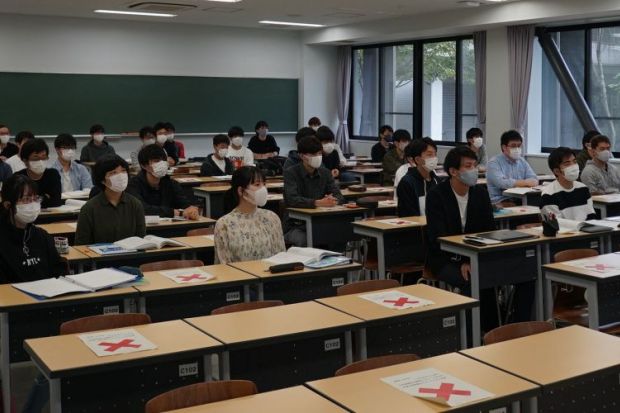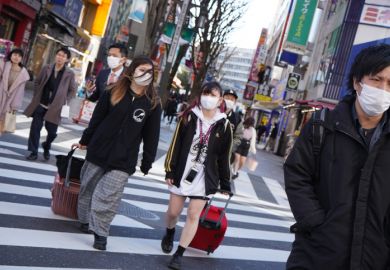After months of closures and online-only teaching, Japan’s autumn term began in October with a cautious and flexible approach to campus reopenings. Even international students, blocked from the country for half a year, are now trickling back.
The reopenings seem to be happening more quickly in regional institutions, such as the country’s top-ranked Tohoku University, several hundred kilometres north of Tokyo. The same is true of the Chubu region, home to several institutions in cities such as Nagoya.
“Universities located in relatively small cities in Japan started our fall semester from October with ‘hybrid’ instruction, ie, a combination of online and face-to-face classes,” Akiyoshi Yonezawa, vice-director of the International Strategy Office at Tohoku University, told Times Higher Education. “We are in the initial stages of going back to normal.”
Large cities, however, have greater challenges such as high urban density, long commutes on public transport and more Covid infections, so are therefore being more cautious. The University of Tokyo, for example, will use face-to-face instruction for only 20 to 30 per cent of classes for first-year students, and 10 to 20 per cent for second-year students.
The shift back to campus comes as a new survey shows that most infections come from social or outside activities, implying that face-to-face instruction may be relatively low risk if precautions are used.
Tohoku researchers gathered open data from universities across Japan and analysed about 350 Covid infections among students, staff and faculty. They concluded that infections happened about “50-50” on- and off-campus. The highest number were from dorms (27 per cent), followed by “other activities” (26 per cent), extracurriculars (19 per cent), parties (18 per cent), travel (7 per cent), jobs (2 per cent) and in-person classes (1 per cent). However, they also cautioned that the 1 per cent was so low because many classes had been suspended.
Like many Asian universities, Tohoku has imposed strict hygiene measures. Even though it has had only three infections, it has implemented daily temperature checks, mandatory mask-wearing, digital movement tracking by QR code, open windows (even in the frigid Japanese winter), a ban on large social gatherings and advice to keep lunchtime conversations “to a minimum”.
A Tohoku spokesperson said there were “no complaints or pushback from students, faculty or staff” so far.
“Our students understand what is at stake,” she said. “After having to stay home and do everything online last semester, they want to be on campus now. They want to see their professors and their friends and have a more normal university experience. And they recognise that for campus to remain open safely, everyone has to follow rules.”
The Japanese government has recommended a resumption of face-to-face classes but is also allowing institutions a degree of autonomy. MEXT, the education ministry, reported last month that 80 per cent of universities were already using hybrid learning. On 16 October, it said it would update the situation next month.
At Tohoku, classes involving laboratory or clinical works are basically back. And while online options are still available, undergraduates are encouraged to attend some “general education” classes in person.
“This is based on our idea that students, especially newly enrolled students, should access real campus life and get into our real university community,” Professor Yonezawa said.
Japan, a country of 126 million, has had more than 93,000 Covid infections and 1,600 deaths as of mid-October.
Register to continue
Why register?
- Registration is free and only takes a moment
- Once registered, you can read 3 articles a month
- Sign up for our newsletter
Subscribe
Or subscribe for unlimited access to:
- Unlimited access to news, views, insights & reviews
- Digital editions
- Digital access to THE’s university and college rankings analysis
Already registered or a current subscriber?








